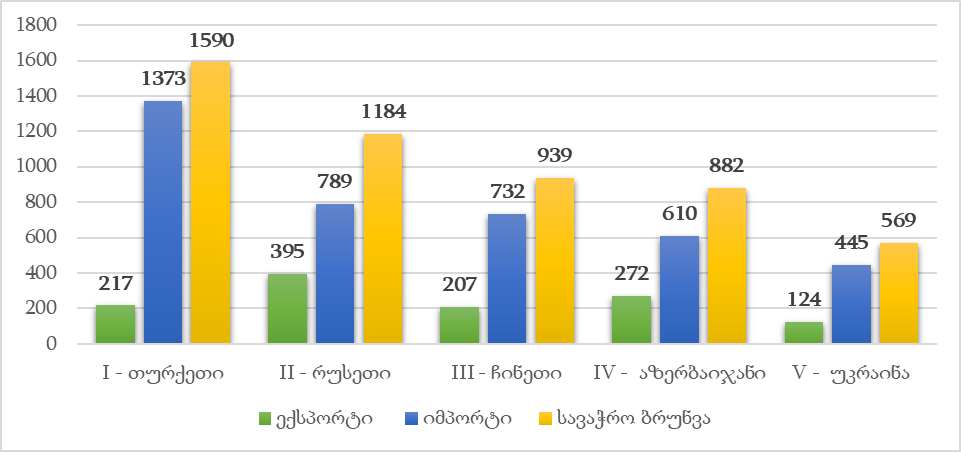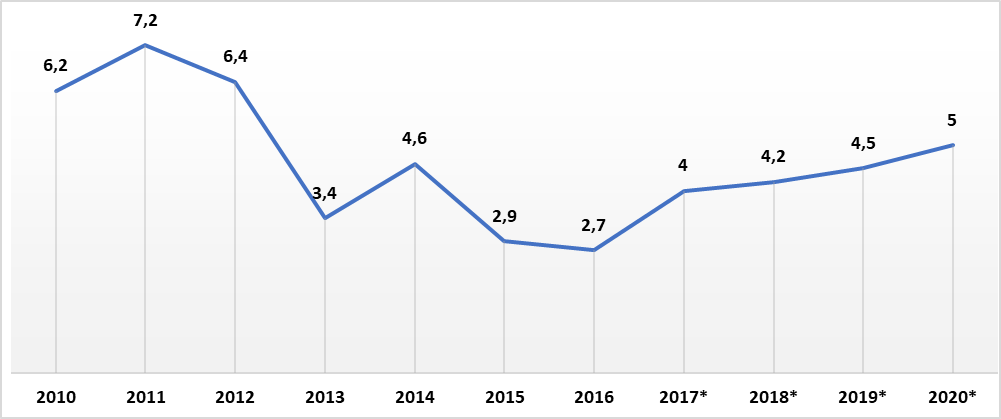The Prime Minister of Georgia, Giorgi Kvirikashvili, in his speech before the Parliament of Georgia stated that in order to offset the deficit from profit tax, administrative expenses were cut and excise tax rate on fuel, tobacco and gambling has increased.
FactCheck took interest in the accuracy of the statement.
Since 1 January 2017, the so called “Estonian Model” has gone into force in Georgia. The new tax system frees entrepreneurs from paying the profit tax in case they put the profit back into business and spend it on development. Tax rate on profit from business was 15%.
In accordance with the information of the State Treasury of the Ministry of Finance of Georgia, income from profit tax in 2017 amounted GEL 756 million, which is GEL 300 million less as compared to 2016 figure. Therefore, the deficit, which Giorgi Kvirikashvili has mentioned in his statement, is GEL 300 million.
Graph 1: Profit Tax to Budget Revenues Ratio in 2013-2017 (GEL million)
 Source: Ministry of Finance of Georgia
Abolition of profit tax has positively impacted the reinvestment figure to Georgia and naturally, contributed to its growth. In accordance with the information of the National Statistics Office of Georgia, in the first three quarters of 2017, of total foreign direct investments 44% was reinvestment. As of first nine months of 2017, reinvestment reached USD 591 million, which is almost twice as high as compared to the same figure (USD 318 million) of the previous year.
The budget deficit, resulting from abolition of profit tax in 2017 was not balanced by cutting administrative expenses. Government’s administrative expenses are sum of goods and services as well as labour remuneration components. In 2017, GEL 1,248 million was spent to purchase goods and services for state administrative purposes, which is GEL 130.7 million more as compared to 2016 figure. The expenses on labour remuneration reached GEL 1,385 million which is GEL 67 million less as compared to 2016 figure. In total, government administrative expenses increased by GEL 64 million in 2017 and reached GEL 2,633 million.
Graph 2: Government Administrative Expenses in 2013-2017
Source: Ministry of Finance of Georgia
Abolition of profit tax has positively impacted the reinvestment figure to Georgia and naturally, contributed to its growth. In accordance with the information of the National Statistics Office of Georgia, in the first three quarters of 2017, of total foreign direct investments 44% was reinvestment. As of first nine months of 2017, reinvestment reached USD 591 million, which is almost twice as high as compared to the same figure (USD 318 million) of the previous year.
The budget deficit, resulting from abolition of profit tax in 2017 was not balanced by cutting administrative expenses. Government’s administrative expenses are sum of goods and services as well as labour remuneration components. In 2017, GEL 1,248 million was spent to purchase goods and services for state administrative purposes, which is GEL 130.7 million more as compared to 2016 figure. The expenses on labour remuneration reached GEL 1,385 million which is GEL 67 million less as compared to 2016 figure. In total, government administrative expenses increased by GEL 64 million in 2017 and reached GEL 2,633 million.
Graph 2: Government Administrative Expenses in 2013-2017
 Source: Ministry of Finance of Georgia
Apart from administrative expenses, state budget’s total expenses increased by GEL 630 million in 2017 as compared to 2016 and reached GEL 9.4 billion. Similar to expenses, budget revenues have also increased, by GEL 1.2 billion. Of that amount GEL 1 billion was tax income. Of note is that 7% inflation (3 percentage points more as compared to planned amount), registered in 2017 in Georgia contributed to the increase in tax incomes (FactCheck has written about that topic). Therefore, in spite of GEL 300 million deficit from profit tax, the government received GEL 1.3 billion more from other taxes in 2017 as compared to 2016. Of that amount, income from excise tax has increased by GEL 370 million (36% more as compared to the previous year), which offsets the deficit from profit tax.
Table 1: Budget Tax Incomes in 2016-2017 (GEL million)
Source: Ministry of Finance of Georgia
Apart from administrative expenses, state budget’s total expenses increased by GEL 630 million in 2017 as compared to 2016 and reached GEL 9.4 billion. Similar to expenses, budget revenues have also increased, by GEL 1.2 billion. Of that amount GEL 1 billion was tax income. Of note is that 7% inflation (3 percentage points more as compared to planned amount), registered in 2017 in Georgia contributed to the increase in tax incomes (FactCheck has written about that topic). Therefore, in spite of GEL 300 million deficit from profit tax, the government received GEL 1.3 billion more from other taxes in 2017 as compared to 2016. Of that amount, income from excise tax has increased by GEL 370 million (36% more as compared to the previous year), which offsets the deficit from profit tax.
Table 1: Budget Tax Incomes in 2016-2017 (GEL million)
Source: Ministry of Finance of Georgia
Conclusion
Budget income from profit tax in 2017 was GEL 300 million less as compared to the same figure in 2016. The deficit from profit tax (GEL300 million) was not balanced by cutting government’s administrative expenses. Funds spent for labour remuneration has decreased by GEL 67 million, although total amount of other administrative expenses grew by GEL 64 million.
Concurrently to decrease the income from profit tax, income from other taxes increased. By increasing excise tax rate on tobacco, fuel and vehicles, state budget received GEL 370 million more in 2017 as compared to 2016. Therefore, the deficit from profit tax was offset by increased incomes both from excise and other taxes.
The Government of Georgia has relinquished part of tax incomes to stimulate the economy. However, in light of this decision, it accumulated funds in state budget in a same way, at the expenses of other taxes. In addition, government expenses are increased and total amount of tax incomes has increased by GEL 490 million without taking inflation into account, which weakens the effect of the “Estonian Model”.
FactCheck concludes that Giorgi Kvirikashvili’s statement is HALF TRUE.
 Source: Ministry of Finance of Georgia
Abolition of profit tax has positively impacted the reinvestment figure to Georgia and naturally, contributed to its growth. In accordance with the information of the National Statistics Office of Georgia, in the first three quarters of 2017, of total foreign direct investments 44% was reinvestment. As of first nine months of 2017, reinvestment reached USD 591 million, which is almost twice as high as compared to the same figure (USD 318 million) of the previous year.
The budget deficit, resulting from abolition of profit tax in 2017 was not balanced by cutting administrative expenses. Government’s administrative expenses are sum of goods and services as well as labour remuneration components. In 2017, GEL 1,248 million was spent to purchase goods and services for state administrative purposes, which is GEL 130.7 million more as compared to 2016 figure. The expenses on labour remuneration reached GEL 1,385 million which is GEL 67 million less as compared to 2016 figure. In total, government administrative expenses increased by GEL 64 million in 2017 and reached GEL 2,633 million.
Graph 2: Government Administrative Expenses in 2013-2017
Source: Ministry of Finance of Georgia
Abolition of profit tax has positively impacted the reinvestment figure to Georgia and naturally, contributed to its growth. In accordance with the information of the National Statistics Office of Georgia, in the first three quarters of 2017, of total foreign direct investments 44% was reinvestment. As of first nine months of 2017, reinvestment reached USD 591 million, which is almost twice as high as compared to the same figure (USD 318 million) of the previous year.
The budget deficit, resulting from abolition of profit tax in 2017 was not balanced by cutting administrative expenses. Government’s administrative expenses are sum of goods and services as well as labour remuneration components. In 2017, GEL 1,248 million was spent to purchase goods and services for state administrative purposes, which is GEL 130.7 million more as compared to 2016 figure. The expenses on labour remuneration reached GEL 1,385 million which is GEL 67 million less as compared to 2016 figure. In total, government administrative expenses increased by GEL 64 million in 2017 and reached GEL 2,633 million.
Graph 2: Government Administrative Expenses in 2013-2017
 Source: Ministry of Finance of Georgia
Apart from administrative expenses, state budget’s total expenses increased by GEL 630 million in 2017 as compared to 2016 and reached GEL 9.4 billion. Similar to expenses, budget revenues have also increased, by GEL 1.2 billion. Of that amount GEL 1 billion was tax income. Of note is that 7% inflation (3 percentage points more as compared to planned amount), registered in 2017 in Georgia contributed to the increase in tax incomes (FactCheck has written about that topic). Therefore, in spite of GEL 300 million deficit from profit tax, the government received GEL 1.3 billion more from other taxes in 2017 as compared to 2016. Of that amount, income from excise tax has increased by GEL 370 million (36% more as compared to the previous year), which offsets the deficit from profit tax.
Table 1: Budget Tax Incomes in 2016-2017 (GEL million)
Source: Ministry of Finance of Georgia
Apart from administrative expenses, state budget’s total expenses increased by GEL 630 million in 2017 as compared to 2016 and reached GEL 9.4 billion. Similar to expenses, budget revenues have also increased, by GEL 1.2 billion. Of that amount GEL 1 billion was tax income. Of note is that 7% inflation (3 percentage points more as compared to planned amount), registered in 2017 in Georgia contributed to the increase in tax incomes (FactCheck has written about that topic). Therefore, in spite of GEL 300 million deficit from profit tax, the government received GEL 1.3 billion more from other taxes in 2017 as compared to 2016. Of that amount, income from excise tax has increased by GEL 370 million (36% more as compared to the previous year), which offsets the deficit from profit tax.
Table 1: Budget Tax Incomes in 2016-2017 (GEL million)
| 2016 | 2017 | |
| Taxes | 7,987 | 8,991 |
| Income Tax | 1,978 | 2,526 |
| Profit Tax | 1,056 | 756 |
| Value Added Tax | 3,286 | 4,123 |
| Excise | 1,070 | 1,451 |
| Import Tax | 70 | 72 |
Tags:







